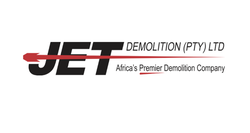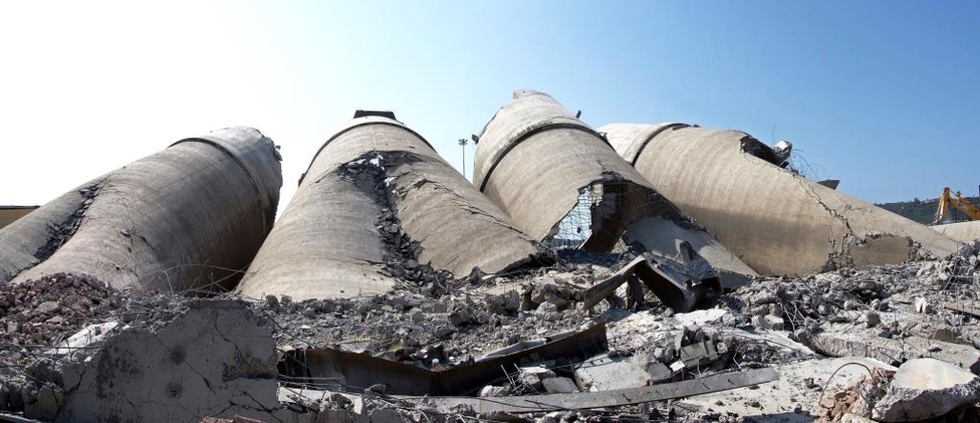Jet Demolition assists mines to cap illegal mining activities
| Jet Demolition assists mines to cap illegal mining activities_approved | 44 KB | Download | |
| Installed rebar cage awaiting concrete 2 | 1.58 MB | Download | |
| Installed rebar cage awating concrete | 1.77 MB | Download | |
| Positioning of pre-cast concrete cap sections | 6.02 MB | Download | |
| Cast cap after stripping of shuttering | 219.62 KB | Download | |
| Casting of high-slump concrete to shaft cap | 297.73 KB | Download |
“The fact is that illegal mining is born from desperation. People are willing to risk their lives by going underground to try and recover pockets of unmined material, as well as copper cable and steel shaft infrastructure. They can be armed, which poses a huge risk. It is not uncommon to witness extreme violence or intimidation in these areas,” Jet Demolition Contracts Manager André Botes (N. Dip. Mechanical Engineering) comments.
The most effective means of ensuring that redundant shafts are protected from occupation by illegal miners is to seal them permanently below natural ground level (NGL), typically after filling the shaft barrel. Here is where specialist demolition contractor Jet Demolition stands to play a vital role.
Its turnkey service offering for the mining industry includes backfilling shaft barrels, designing permanent caps, installing caps at a defined depth below NGL, and recording the final position and depth of caps, followed by the backfill and reinstatement of the natural material over cap tops.
Mining houses typically require such a turnkey service for two main scenarios: Firstly, to seal the shaft permanently as a mitigating factor, thereby preventing unauthorised access by illegal miners or, secondly, to rehabilitate the mining footprint fully, rendering the area safe for public use.
Another challenge is that various shafts are often interconnected, such as a live shaft and a redundant shaft linking together hundreds of meters below NGL. “It is thus critical to ensure that we understand the network we are operating within, so that our capping and sealing activities do not influence or adversely affect miners underground in a neighbouring shaft,” Botes stresses.
The main requirement for permanent shaft sealing and capping projects is to ensure full compliance with the Mine Health and Safety Act, and the provisions of the Department of Mineral Resources, the approved Environmental Management Plan, as well as any client-specific requirements.
The natural surrounding environment also has to be taken into account, paying special attention to natural water courses and stormwater management. This could mean rerouting natural water courses slightly, while ensuring there is no subsequent negative downstream effect. All material used to fill shafts must be clean and uncontaminated. This is vital to ensure that no groundwater contamination will occur after sealing.
“We have also sealed a few shafts that had to be equipped with monitoring access points as part of the Acid Mine Drainage (AMD) project in the Western, Central and Eastern Basins of the Witwatersrand Goldfields. These access points will be used to monitor the quality and volume of subsurface water in the foreseeable future,” Botes reveals.
Jet Demolition pays particular attention to health and safety, especially when working over an open shaft that could extend a few kilometres underground. “It is absolutely critical to protect plant and personnel from falling,” Botes stresses. Hence certified lifelines are installed prior to any work commencing, providing personnel with anchoring points during shaft sealing. Larger machines are also typically used for increased reach.
Ends
Connect with Jet Demolition on Social Media to receive the company’s latest news
Facebook: https://www.facebook.com/JetDemolition/?ref=br_rs
LinkedIn: https://www.linkedin.com/company/jet-demolition-pty-ltd/
Notes to the Editor
To download hi-res images for this release, please visit http://media.ngage.co.za and click the Jet Demolition link to view the company’s press office.
About Jet Demolition
Jet Demolition has been undertaking industrial demolition works since 1994, and is the leading, largest, and most technically-advanced demolition company in Africa. It offers in-house, full-range demolition services, including advanced mechanical solutions and controlled implosions. It actively pursues ongoing development of skills and equipment suited to the changing needs of the industry.
Jet Demolition is a technically-based company, with various staff members holding MSc, BSc, and BTech Degrees, as well as National Diplomas, in various engineering fields. This expertise gives it the technical foundation to successfully engineer solutions for large and complex demolition projects, and furthermore fuels its drive to deliver quality projects safely. Jet Demolition strives to offer its clients innovative and technical solutions to demanding demolition challenges.
Jet Demolition Contact
Kate Bester (N. Dip. Civil Engineering)
Contracts Manager
Phone: (011) 495 3800
Cell: 072 811 5310
Email: kate [at] jetdemolition [dot] co [dot] za
Web: www.jetdemolition.co.za
Media Contact
Renay Tandy
NGAGE Public Relations
Phone: (011) 867 7763
Fax: 086 512 3352
Cell: 082 562 5088
Email: renay [at] ngage [dot] co [dot] za
Web: www.ngage.co.za
Browse the NGAGE Media Zone for more client press releases and photographs at http://media.ngage.co.za

